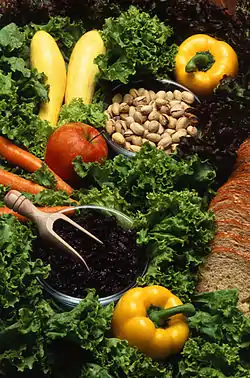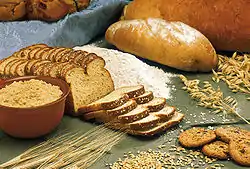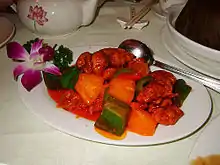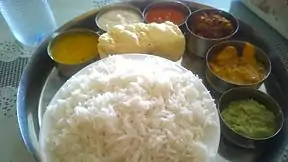Vegetarian cuisine
Vegetarian cuisine is based on food that meets vegetarian standards by not including meat and animal tissue products (such as gelatin or animal-derived rennet).[1] For lacto-ovo vegetarianism (the most common type of vegetarianism in the Western world), eggs and dairy products (such as milk and cheese without rennet) are permitted. For lacto vegetarianism, dairy products are permitted but eggs are not, and for ovo vegetarianism eggs are permitted but dairy products are not.[2] The strictest form of vegetarianism is veganism, which excludes all animal products, including dairy, honey, and some refined sugars if filtered and whitened with bone char.[3] There are also partial vegetarians (flexitarians), such as pescetarians who may eat fish but avoid other types of meat.[3]

Vegetarian foods can be classified into several different types:
- Traditional foods that have always been vegetarian include cereals, grains, fruits, vegetables, legumes and nuts.
- Soy products, including tofu and tempeh, which are common protein sources.
- Textured vegetable protein (TVP), made from defatted soy flour, often included in chili and burger recipes in place of ground meat.
- Meat analogues, which mimic the taste, texture, and appearance of meat and are often used in recipes that traditionally contained meat.
- Eggs and dairy product analogues in vegan cuisine (such as aquafaba, plant cream or plant milk).
Commonly used vegetarian foods

Food regarded as suitable for all vegetarians (including vegans) typically includes:
- Cereals/grains: barley, buckwheat, corn, fonio, hempseed, maize, millet, oats, quinoa, rice, rye, sorghum, triticale, wheat; derived products such as flour (dough, bread, baked goods, cornflakes, dumplings, granola, Muesli, pasta etc.).
- Vegetables (fresh, canned, frozen, pureed, dried or pickled); derived products such as vegetable sauces like chili sauce and vegetable oils.
- Edible fungi (fresh, canned, dried or pickled).[note 1]
- Fruit (fresh, canned, frozen, pureed, candied or dried); derived products such as jam and marmalade.
- Legumes: beans (including soybeans and soy products such as miso, soy milk, soy yogurt, tempeh, tofu and TVP), chickpeas, lentils, peas, peanuts; derived products such as peanut butter.
- Tree nuts and seeds; derived products such as nut butter.
- Herbs, spices and wild greens such as dandelion, sorrel or nettle.
- Other foods such as seaweed derived products such as agar, which has the same function as animal bone derived gelatin.
- Beverages such as beer, coffee, hot chocolate, lemonade, tea or wine.
Foods not suitable for vegans, but acceptable for some other types of vegetarians:
- Dairy products (butter, cheese (except for cheese containing rennet of animal origin), milk, yogurt (excluding yogurt made with gelatin) etc.) – not eaten by vegans and pure ovo-vegetarians
- Eggs – not eaten by pure vegetarians, vegans and lacto-vegetarians (most Indian vegetarians)
- Honey – not eaten by most vegans
Vegetarians by definition cannot consume meat or animal tissue products. There are other differences in their diet however. Compared to non-vegetarians, vegetarians have an increased consumption in:
- Fruits
- Vegetables
- Avocados
- Non-fried potatoes
- Whole grains
- Legumes
- Soy foods
- Nuts
- Seeds
Vegetarians have an decreased consumption in:
- Dairy products
- Eggs
- Refined grains
- Added fats
- Sweets
- Snacks
- Non-water beverages
These differences explain a difference in health outcomes between vegetarians and non-vegetarians.[4]
Traditional vegetarian cuisine
| Wikibooks Cookbook has a recipe/module on |
These are some of the most common dishes that vegetarians eat without substitution of ingredients. Such dishes include, from breakfasts to dinnertime desserts:

- Traditionally, Brahmin cuisines in most part of India, except Odisha and West Bengal, are strictly vegetarian.
- Gujarati cuisine from the state of Gujarat in western India is predominantly vegetarian.
- Many bean, pasta, potato, rice, and bulgur/couscous dishes, stews, soups and stir-fries.
- Cereals and oatmeals, granola bars, etc.
- Fresh fruit and most salads
- Potato salad, baba ganoush, pita-wraps or burrito -wraps, vegetable pilafs, baked potatoes or fried potato-skins with various toppings, corn on the cob, smoothies
- Many sandwiches, such as cheese on toast, and cold sandwiches including roasted eggplant, mushrooms, bell peppers, cheeses, avocado and other sandwich ingredients
- Numerous side dishes, such as mashed potatoes, scalloped potatoes, some bread stuffings, seasoned rice, and macaroni and cheese.
- Classical Buddhist cuisine in Asia served at temples and restaurants with a green sign indicating vegetarian food only near temples
National cuisines

- Chinese (and other East Asian) dishes based on the main ingredients being mushroom, noodles, eggplant, string beans, broccoli, rice, tofu, most tong sui or mixed vegetables.
- Georgian cuisine such as ajapsandali, nigvzinai badrijani, badrijnis borani, badrijnis khizilala, badrijani mtsvanilit, ekala nigvzit, ghomi, gogris gupta, khinkali with mushrooms, lobiani, lobio, lobio nigvzit, mchadi, mkhlovani, pkhali, salati nigvzit, shechamandi, shilaplavi, which feature eggplants, walnuts, kidney beans, mushrooms, pomegranates, garlic, squash, onions, tomatoes, cucumbers, bell peppers, chili peppers, beets, fresh herbs (coriander, parsley, basil etc.), smilax, cabbage, spinach, and red/white wine vinegar.
- Indian cuisine in Asia is replete with vegetarian dishes, many of which can be traced to religious traditions (such as Jain and Hindu). Gujarati cuisine of India is predominantly vegetarian among other Indian cuisines: Gujarati thali is very famous among Indians. There are many vegetarian Indian foods such as pakora, samosa, khichris, Pulao, raitas, rasam, bengain bharta, chana masala, some kormas, sambar, jalfrezis, saag aloo, subjis (vegetable dishes) such as bindi subji, gobi subji, Punjabi chole, aloo matar and much South Indian food such as dosas, idlis and vadas. Chapati and other wheat/maida based breads like naan, roti parathas are often stuffed with vegetarian items to make it a satisfying meal. Many Indian dishes also qualify as vegan, though many others use honey or dairy.

- In Indonesia, vegetarianism is well served and represented, as there are plenty selection of vegetarian dishes and meat substitutes. Dishes such as gado-gado, karedok, ketoprak, pecel, urap, rujak and asinan are vegetarian. However, for dishes that use peanut sauce, such as gado-gado, karedok or ketoprak, might contains small amount of shrimp paste for flavor. Served solely, gudeg can be considered a vegetarian food, since it consists of unripe jackfruit and coconut milk. Fermented soy products, such as tempeh, tofu and oncom are prevalent as meat substitutes, as the source of protein. Most of Indonesians do not practice strict vegetarianism and only consume vegetables or vegetarian dishes for their taste, preference, economic and health reasons. Nevertheless, there are small numbers of Indonesian Buddhists who practice vegetarianism for religious reason.
- Japanese foods such as castella, dorayaki, edamame, name kojiru, mochi, taiyaki, tempura, vegetable sushi and wagashi. Miso soup is made from fermented white or red soy bean paste, garnished with scallions or seaweed. Although most traditional versions are made from fish stock (dashi), it can be made with vegetable stock as well.
- Korean cuisine has some dishes that are often vegetarian. One example is bibimbap, which is rice with mixed vegetables. Sometimes this dish contains beef or other non-vegetarian ingredients. Another Korean food which is sometimes vegetarian is jeon, in which ingredients (most commonly vegetables and/or seafood) are coated in a flour and egg batter and then pan-fried in oil.
- Cuisine of the Mediterranean such as tumbet and many polentas and tapas dishes.
- Mexican foods such as salsa and guacamole with chips, rice and bean burritos (without lard in the refried beans or chicken fat in the rice), huevos rancheros, veggie burrito, many quesadillas, bean tacos, some chilaquiles and bean-pies, chili sin carne, black beans with rice, some chiles rellenos, cheese enchiladas and vegetable fajitas.
- Italian foods such as most pastas, many pizzas, bruschetta, caponata, crostini, eggplant parmigiana, Polenta and many risottos.
- Continental cuisine such as braised leeks with olives and parsley, ratatouille, many quiches, sauteed Brussels sprouts with mushrooms, sauteed Swiss chard, squash and vegetable-stuffed mushrooms.
- In Germany, Frankfurt green sauce, Klöße with vegetarian sauces (e.g., Chanterelle), cheese or vegetable stuffed Maultaschen, combinations of quark, spinach, potatoes and herbs provide some traditional vegetarian summer dishes. Traditionally on Fridays, southern Germany broad variety of sweet dishes may be served as a main course, such as Germknödel and Dampfnudel. Potato soup and plum cake are traditional Friday dishes in the Palatinate. Brenntar in Swabia, it is made of roasted flour, usually spelt flour or oat flour.
- Many Greek and Balkan dishes, such as briam, dolmas (when made without minced meat), fasolada, gemista, vegetable based moussaka and spanakopita.

- Russian cuisine developed a significant vegetarian tradition in czarist time, based on the example of Leo Tolstoy.[5] The orthodox tradition of separating meat and vegetables and as well between specific meals for fasting and other holidays contributed to a rich variety of vegetarian dishes[5] in Russia and Slavic countries, such as soups (vegetable borscht, shchi, okroshka), pirogi, blini, vareniki, kasha, buckwheat, fermented and pickled vegetables, etc.
- Many Ethiopian dishes such as injeera or Ethiopian vegetable sauces or chillies.
- Mideastern food such as falafel, hummus (mashed chick peas), tahini (ground sesame seeds), minted-yogurts, and couscous.
- Egyptian cuisine in particular is rich in vegetarian foods. For reasons ranging from economics to the religious practices of the Coptic Orthodox Church, most Egyptian dishes rely on beans and vegetables: the national dishes, kushari and ful medames, are entirely vegetarian, as are usually the assorted vegetable casseroles that characterize the typical Egyptian meal.
- Many dishes in Thai cuisine can be made vegetarian if the main protein element is substituted by a vegetarian alternative such as tofu. This includes dishes such as phat khi mao and, if a vegetarian shrimp paste and fish sauce substitute is used, many Thai curries. Venues serving vegetarian Buddhist cuisine (ahan che; Thai: อาหารเจ) can be found all over Thailand.
- Creole and Southern foods such as hush puppies, okra patties, rice and beans, or sauteed kale or collards, if not cooked with the traditional pork fat or meat stock.
- Some Welsh recipes, including Glamorgan sausages, laverbread and Welsh rarebit.

Desserts and sweets
Most desserts, including pies, cobblers, cakes, brownies, cookies, truffles, Rice Krispie treats (from gelatin-free marshmallows or marshmallow fluff), peanut butter treats, pudding, rice pudding, ice cream, crème brulée, etc., are free of meat and fish and are suitable for ovo-lacto vegetarians. Eastern confectionery and desserts, such as halva and Turkish delight, are mostly vegan, while others such as baklava (which often contains butter) are lacto vegetarian. Indian desserts and sweets are mostly vegetarian like peda, barfi, gulab jamun, shrikhand, basundi, kaju katri, rasgulla, cham cham, rajbhog, etc. Indian sweets are mostly made from milk products and are thus lacto vegetarian; dry fruit-based sweets are vegan.
Meat analogues





A meat analogue is a meat-like substance made from plants. More common terms are plant-based meat, vegan meat, meat substitute, mock meat, meat alternative, imitation meat, or vegetarian meat, or, sometimes more pejoratively, fake meat or faux meat. Meat analogues typically approximate certain aesthetic qualities (such as texture, flavor, appearance) or chemical characteristics of specific types of meat. Generally, meat analogue means a food made from vegetarian ingredients, and sometimes without animal products such as dairy. Many analogues are soy-based (e.g. tofu, tempeh) or gluten-based, but now may also be made from pea protein. Other less common analogues include ingredients like mycoprotein.
Because of their similarity to meats, they are frequently used in dishes and food practices similar to meat. The target market for meat analogues includes vegetarians, vegans, non-vegetarians seeking to reduce their meat consumption,[6][7] and people following religious dietary laws in Hinduism, Judaism, Islam, and Buddhism.
Increasingly, the global demand for sustainable diets in response to the outsized role animal products play in global warming and other environmental impacts has seen an increase in industries focused on finding substitutes similar to meat. However, the motivation for seeking out mock meats tends to vary depending on consumer group. The market for meat alternatives is highly dependent on "meat-reducers" — a consumer group who is primarily motivated by health consciousness and weight management. Consumers who identify as vegan, vegetarian or pescetarian are more likely to endorse concerns regarding animal welfare and/or environmentalism as primary motivators.[7][8]
Meat substitution has a long history. Tofu, a popular meat analogue made from soybeans, was known in China during the period of the Western Han dynasty (206 BCE – 9 CE).[9] A document written by Tao Gu (903–970) describes how tofu was called "small mutton" and valued as an imitation meat. Meat analogues such as tofu and wheat gluten are associated with Buddhist cuisine in China and other parts of East Asia.[10] In Medieval Europe, meat analogues were popular during the Christian observance of Lent, when the consumption of meat from warm-blooded animals is forbidden.[11]
In the 2010s, owing to concern over global warming, human population size, and major investments by companies such as Impossible Foods and Beyond Meat, there was an increase in awareness and the market size for meat analogues in Western and Westernized markets.Commercial products

Commercial products, marketed especially towards vegetarians and labeled as such, are available in most countries worldwide, in varying amounts and quality. As example, in Australia, various vegetarian products are available in most of supermarket chains and a vegetarian shopping guide is provided by Vegetarian/Vegan Society of Queensland.[12] However, the biggest market for commercially vegetarian-labeled foods is India, with official governmental laws regulating the "vegetarian" and "non vegetarian" labels.
Health Benefits
Vegetarian diets are associated with a number of favorable health outcomes in epidemiological studies. In a study supported by the National Institutes of Health Grant, dietary patterns were evaluated along with their relationship with metabolic risk factors and metabolic syndromes.[13] A cross-sectional analysis of 773 subjects including 35% vegetarians, 16% semi-vegetarians, and 49% non-vegetarians. The study found that a vegetarian dietary pattern is associated significantly with lower means for all metabolic risk factors except HDL and a lower risk of having metabolic syndromes when compared to non-vegetarian diets. Metabolic risk factors include HDL, triglycerides, glucose, systolic blood pressure, diastolic blood pressure, waist circumference, and body mass index. Metabolic syndromes are a cluster of disorders associated with a heightened risk of diabetes and cardiovascular disease. Adventist Study 2 (AHS-2) compared mean consumption of each food group for vegetarian patterns compared to non-vegetarian patterns.[14] Increase health benefits can be explained by increase in certain foods, not just the lack of animal products.
As evident by the Adventist Study 2 (AHS-2), the vegetarian diet does not always cause health benefits. This is dependent on the specific foods in the vegetarian diet. The National Institute of Health recommends a 1600 calories a day lacto-ovo vegetarian cuisine for the diet. This recommended diet includes oranges, pancakes, milk, and coffee for breakfast, vegetable soup, bagels, american cheese, and spinach salad for lunch, and omelettes, mozzarella cheesee, carrots, and whole wheat bread, and tea for dinner.[15]
See also
- Indian vegetarian cuisine
- Chinese Buddhist cuisine
- Korean vegetarian cuisine
- Veganism
- List of meat substitutes
- List of vegetable dishes
- List of vegetarian restaurants
- List of vegetarian and vegan companies
- South Asian Veggie Table - Vegetarian cooking television show
- Vegetarian Cooking for Everyone
- Vegetarian and vegan symbolism
Notes
- Edible fungi include some mushrooms and cultured microfungi (yeasts and moulds) such as Aspergillus oryzae and Fusarium venenatum, though some strict Indian vegetarians do not eat mushrooms.
References
- Rosell, Magdalena S.; Appleby, Paul N.; Key, Timothy J. (February 2006). "Health effects of vegetarian and vegan diets". Proceedings of the Nutrition Society. 65 (1): 35–41. doi:10.1079/PNS2005481. ISSN 1475-2719. PMID 16441942.
- "International Vegetarian Union - The Origins of Some Words".
- Harvard Health Publishing (4 December 2017). "Becoming a vegetarian". Harvard Health Publishing. Retrieved 8 October 2018.
- Orlich, Michael J.; Jaceldo-Siegl, Karen; Sabaté, Joan; Fan, Jing; Singh, Pramil N.; Fraser, Gary E. (November 2014). "Patterns of food consumption among vegetarians and non-vegetarians". British Journal of Nutrition. 112 (10): 1644–1653. doi:10.1017/S000711451400261X. ISSN 0007-1145.
- Peter Brang. Ein unbekanntes Russland, Kulturgeschichte vegetarischer Lebensweisen von den Anfängen bis zur Gegenwart An ignored aspect of Russia. Vegetarian lifestyles from the very beginning till the present day. Böhlau Verlag, Köln 2002 ISBN 3-412-07902-2
- Schwab, Katharine (2019-07-25). "These plant-based food companies are rebranding to target meat eaters—and it's working". Fast Company. Retrieved 2020-09-03.
- "CONSUMER INSIGHTS" (PDF). AHDB. July 2018. Retrieved September 2, 2020.
- Penny, J. C.; Swift, J. A.; Salter, A. M. (2015). "'Meat reducers': meat reduction strategies and attitudes towards meat alternatives in an emerging group". Proceedings of the Nutrition Society. 74 (OCE5). doi:10.1017/S0029665115003602. ISSN 0029-6651.
- DuBois, Christine; Tan, Chee-Beng; Mintz, Sidney (2008). The World of Soy. National University of Singapore Press. pp. 101–102. ISBN 978-9971-69-413-5.
- Anderson, E.N. (2014). "China". Food in Time and Place. University of California Press. p. 44. ISBN 978-0-520-95934-7.
- Adamson, Melitta Weiss (2004). Food in Medieval Times. Greenwood Publishing Group. p. 72. ISBN 978-0-313-32147-4.
- Vegetarian/Vegan Society of Queensland. "Vegetarian/Vegan Supermarket Shopping Guide". Archived from the original on 20 May 2009. Retrieved 7 May 2009.
- Rizzo, Nico S.; Sabaté, Joan; Jaceldo-Siegl, Karen; Fraser, Gary E. (2011-05-01). "Vegetarian Dietary Patterns Are Associated With a Lower Risk of Metabolic Syndrome: The Adventist Health Study 2". Diabetes Care. 34 (5): 1225–1227. doi:10.2337/dc10-1221. ISSN 0149-5992. PMID 21411506.
- Orlich, Michael J.; Jaceldo-Siegl, Karen; Sabaté, Joan; Fan, Jing; Singh, Pramil N.; Fraser, Gary E. (November 2014). "Patterns of food consumption among vegetarians and non-vegetarians". British Journal of Nutrition. 112 (10): 1644–1653. doi:10.1017/S000711451400261X. ISSN 0007-1145.
- "Lacto-Ovo Vegetarian Cuisine". www.webharvest.gov. Retrieved 2020-11-07.
External links
| Wikimedia Commons has media related to Vegetarian food. |
| Look up vegetarian in Wiktionary, the free dictionary. |
| Wikiquote has quotations related to: Vegetarian cuisine |


